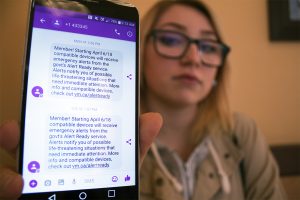Get ready for Alert Ready

Sydney Trumbley displays messages from her service provider informing her of the alert system. (Photo by Matt Flood)
By: Matt Flood
An alert system is coming to Canadians across the country to deliver critical and potentially life-saving alerts directly to their wireless devices.
The system, called Alert Ready, will officially be in action on April 6 to alert residents in designated regions of the country of potential life-threatening events. Canadians with eligible devices will receive LTE messages from public officials designated by their province or territory in case of emergency. Those designated could be, but are not limited to officials from Environment Canada, fire marshals and provincial police forces. Reasons for alerts range from environmental and man-made hazards to deadly attacks.
Wireless service providers were directed by the Canadian Radio-television and Telecommunications Commission on April 6, 2017 to implement a wireless public alerting system on their LTE networks within one year.
The effects of this implementation have become apparent in recent weeks as citizens across Canada have started to receive messages from their wireless service providers informing them the Alert Ready service is on the way.
But some people are being left out of the loop.
Aimee Comtois, a 20-year-old whose service provider Freedom Mobile, has learned she is not eligible to receive emergency alerts. She said it was because she has a different kind of phone not very common in Canada and it is an older model.
“It is not a Samsung or an iPhone, it’s a different company,” said Comtois. “I got a text from them telling me what kind of phones are eligible and it is not on that list.”
Different service providers support the service on certain phones and not others, while many claim they are planning to add more eligible phones to the service.
The idea for the wireless alert system began to take form in 2014 when the Canadian Radio-television and Telecommunications Commission had their Interconnection Steering Committee Network Technology Working Group assist in developing technical requirements for the wireless public service arriving next month. At this time emergency alerts had begun to be sent through Canadian radio broadcasters and television service providers due to the CRTC.
Over the course of the next few years the Working Group worked to create an awareness campaign and test schedules while Defence Research and Development Canada’s Centre for Security Science worked to create and test an effective wireless public alerting service.
Despite their efforts, the CRTC states the service is designed with the latest software in mind, meaning older phones will likely be left without the service available.
Comtois is not worried about this. She believes in the case of an emergency other forms of alerting will ensure she is informed.
“It is not like radios don’t have them, TV, anything and it’s not like Facebook doesn’t already do it with their alerts, Twitter or Google weather,” said Comtois. “Someone would definitely message me or text me or call me or let me know. If you find out about something like that the first thing you’re going to do is call someone and let someone know.”
A specific feature of the alerting system has created a small stir of controversy: you cannot opt out. If your service provider deems your device eligible to receive alerts you will be unable to turn the alert system off.
Sydney Trumbley, a 19-year-old McDonald’s manager, believes people should be able to opt out of the alert system.
“I think they should be able to opt out especially because some people just do not care about life threatening situations, they might not even believe in it because there is definitely been a lot of false threats so I feel like if they do not want it, it shouldn’t be mandatory,” said Trumbley.
Be ready to hear test alerts for the system in early May. One can get used to the ominous, piercing sound by visiting the Alert Ready website and listening to the provided sample.


